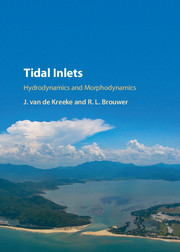Book contents
- Frontmatter
- Contents
- Preface
- 1 Introduction
- 2 Geomorphology
- 3 Sand Transport Pathways
- 4 Sand Transport and Sand Bypassing at Selected Inlets
- 5 Empirical Relationships
- 6 Tidal Inlet Hydrodynamics; Excluding Depth Variations with Tidal Stage
- 7 Tidal Inlet Hydrodynamics; Including Depth Variations with Tidal Stage
- 8 Cross-Sectional Stability of a Single Inlet System
- 9 Cross-Sectional Stability of a Double Inlet System, Assuming a Uniformly Varying Basin Water Level
- 10 Cross-Sectional Stability of a Double Inlet System, Assuming a Spatially Varying Basin Water Level
- 11 Morphodynamic Modeling of Tidal Inlets Using a Process-Based Simulation Model
- 12 Morphodynamic Modeling of Tidal Inlets Using an Empirical Model
- 13 River Flow and Entrance Stability
- 14 Engineering of Tidal Inlets
- References
- Index
9 - Cross-Sectional Stability of a Double Inlet System, Assuming a Uniformly Varying Basin Water Level
Published online by Cambridge University Press: 04 July 2017
- Frontmatter
- Contents
- Preface
- 1 Introduction
- 2 Geomorphology
- 3 Sand Transport Pathways
- 4 Sand Transport and Sand Bypassing at Selected Inlets
- 5 Empirical Relationships
- 6 Tidal Inlet Hydrodynamics; Excluding Depth Variations with Tidal Stage
- 7 Tidal Inlet Hydrodynamics; Including Depth Variations with Tidal Stage
- 8 Cross-Sectional Stability of a Single Inlet System
- 9 Cross-Sectional Stability of a Double Inlet System, Assuming a Uniformly Varying Basin Water Level
- 10 Cross-Sectional Stability of a Double Inlet System, Assuming a Spatially Varying Basin Water Level
- 11 Morphodynamic Modeling of Tidal Inlets Using a Process-Based Simulation Model
- 12 Morphodynamic Modeling of Tidal Inlets Using an Empirical Model
- 13 River Flow and Entrance Stability
- 14 Engineering of Tidal Inlets
- References
- Index
Summary
Introduction
Instead of one inlet, many back-barrier lagoons, bays and inland seas are connected to the ocean by multiple inlets. Examples are the Ría Formosa in south Portugal (Salles et al., 2005), the Dutch, German and Danish Wadden Sea (Ehlers, 1988) and the Venice Lagoon in Italy (Tambroni and Seminara, 2006); see Fig. 1.1. This chapter concerns the interaction of these inlets, with emphasis on cross-sectional stability.
Depending on the hydraulic efficiency, inlets connecting the same back-barrier lagoon capture a smaller or larger part of the tidal prism. The tidal prism is the volume of water entering and leaving the back-barrier lagoon during a tidal cycle. The fraction of the tidal prism entering and leaving an individual inlet is the prime parameter determining the cross-sectional stability of that inlet. If this fraction is too small, the inlet closes. In this respect the opening of a new inlet is of interest. Potentially, the new inlet could lead to a decrease of the tidal prisms of the already existing inlet(s) and chances are that some of these inlets close. In that case, it has to be decided to either close the new inlet or leave it open
An example of a recently opened inlet is the Breach at Old Inlet on Fire Island, NY (Fig. 2.1). The inlet was opened in October 2012 during hurricane Sandy. Together with the already existing Fire Island Inlet, the Breach at Old Inlet connects Great South Bay to the ocean. To determine the behavior of the new inlet and its effect on Fire Island Inlet, both inlets are being monitored (National Park Service, 2012). As of March 2015, the Breach at Old Inlet was still open. Based on the monitoring results it might be possible to arrive at a rational decision to either close the inlet or leave it open.
In this chapter, as a first step to determine the cross-sectional stability of tidal inlets connecting the same back-barrier lagoon to the ocean, the method used to determine the cross-sectional stability of a single inlet system (Chapter 8) is expanded and applied to a double inlet system.
Information
- Type
- Chapter
- Information
- Tidal InletsHydrodynamics and Morphodynamics, pp. 86 - 99Publisher: Cambridge University PressPrint publication year: 2017
